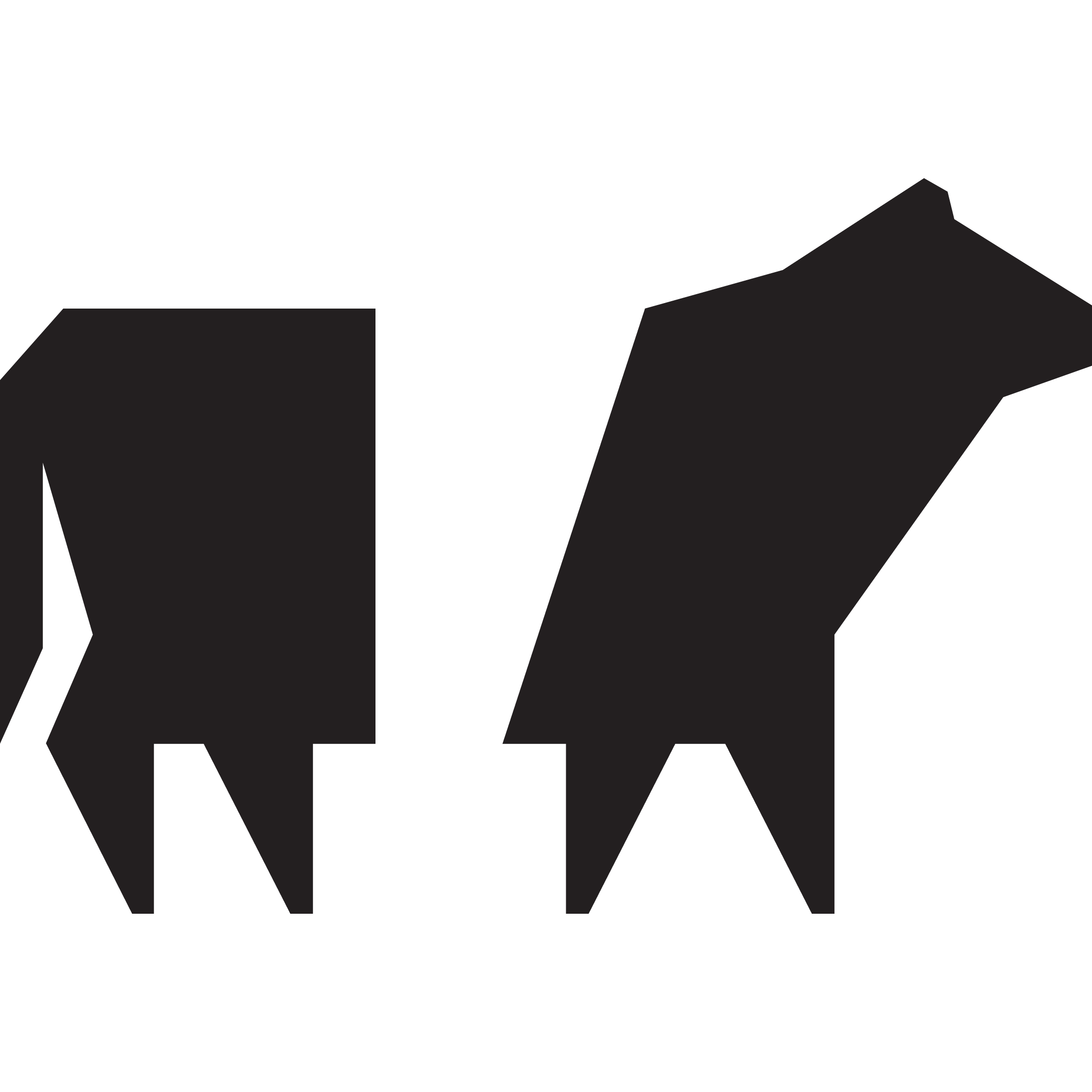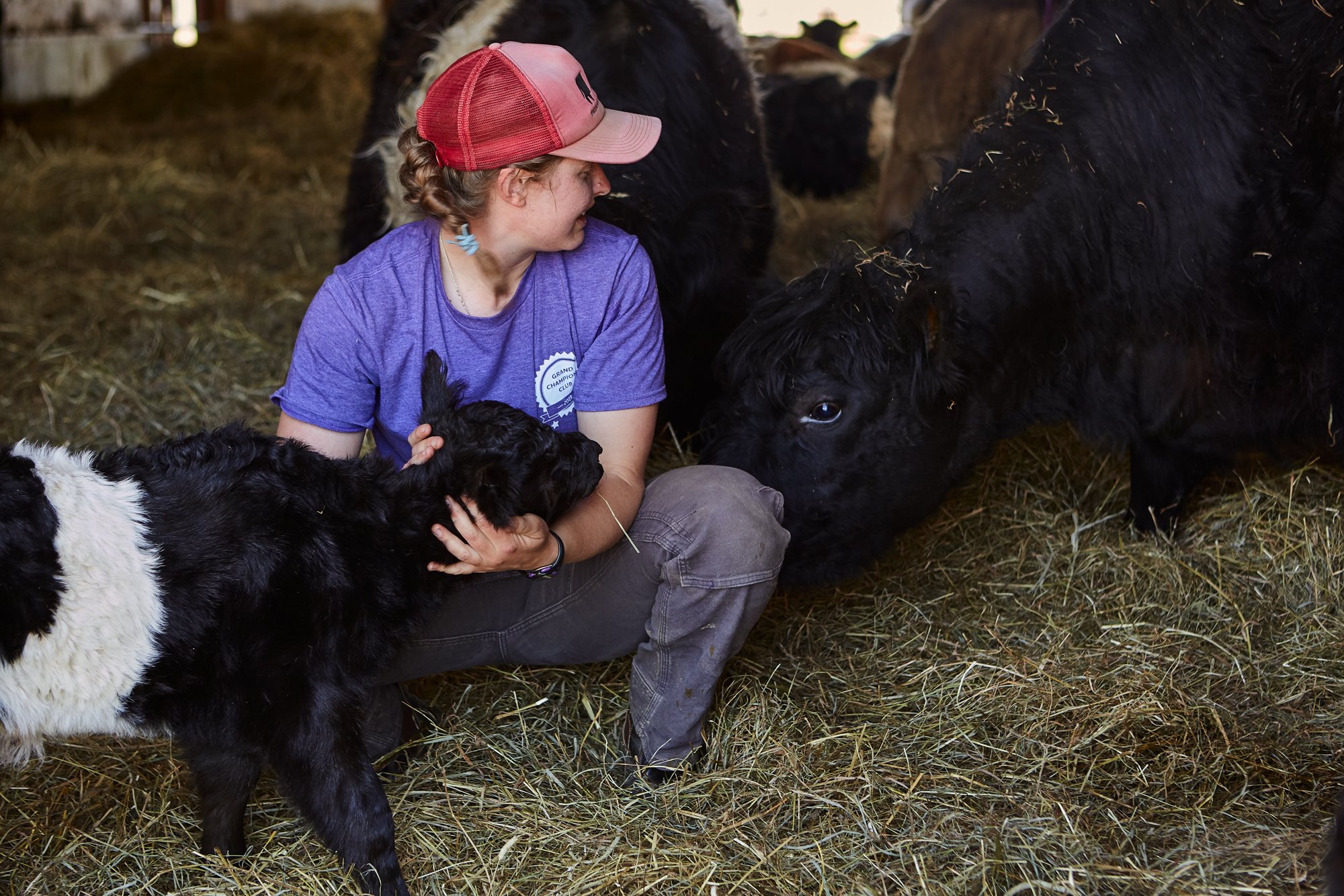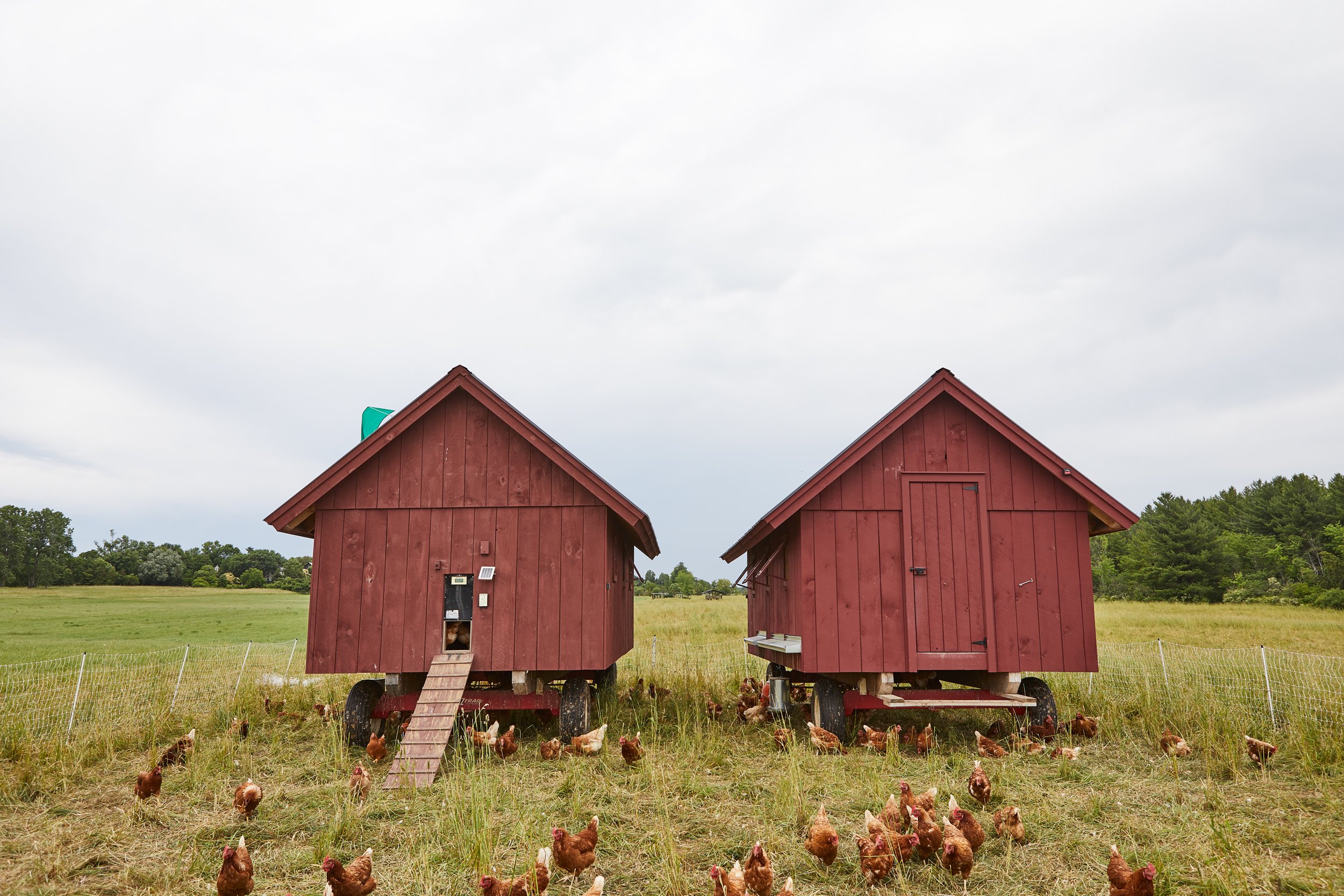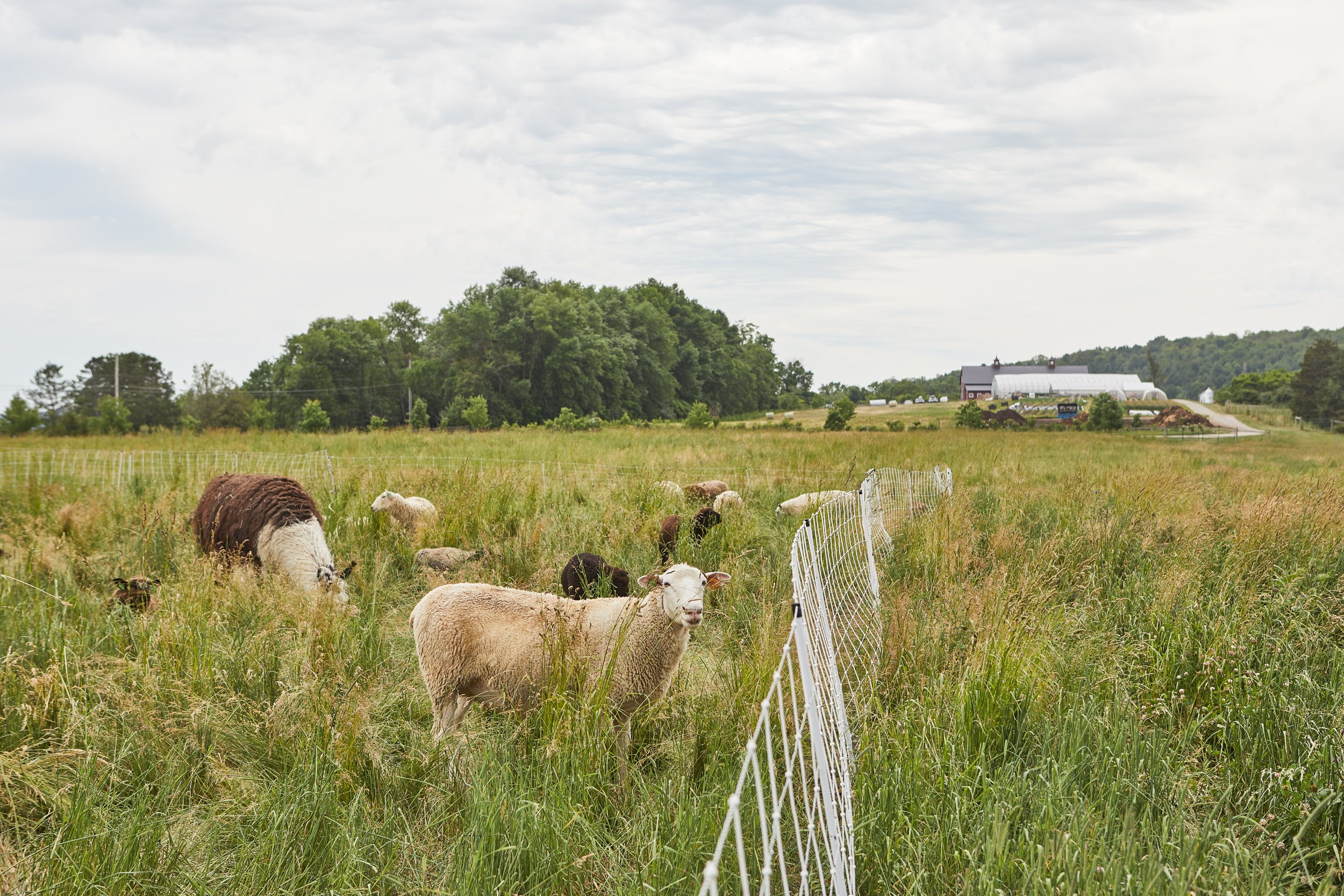Agricultural Research Program
We take an entire ecosystem into account when making decisions around our growing practices and aim to have a net positive impact on the environment. Our fruit and vegetable growing and pasture-management practices reflect Philo Ridge Farm’s desire to produce all food within a regenerative agricultural system. The core pillars of our system are building healthy soils, increasing water infiltration, enhancing biodiversity and ecosystem resilience, and reducing carbon emissions through carbon sequestration. We practice managed intensive rotational grazing, use cover crops as part of our crop rotation, apply on-farm compost annually, plant native perennials, and continually explore more regenerative practices to foster the health of our land and our climate.
Soil is complex: it requires proper mineral, microbial, and structural properties to build soil organic matter and grow things well. Philo Ridge Farm is located on the Vergennes and Covington Soil series. This series consists of soils that are generally deep, moderately well drained, and typically clay to silty-clay throughout their profile. Prior to 2012, most of our fields were used for conventional corn and hay production, which required annual plowing. This conventional plowing practice compacted the soil and resulted in reduced organic matter and fertility. By stewarding this land with rotational grazing instead of conventional, equipment-reliant practices, we are using animals to enrich the soil’s organic matter and nutrient content, which subsequently improves the vitality, resilience, and biodiversity of this landscape. Over the past few years through our research program we’ve been able to track and show that these practices have increased our soil organic matter and soil organic carbon.
We test and validate regenerative agricultural practices for a few reasons. The first is to enhance research and data collection to support the quantitative assessment of these practices and establish collaborations with the surrounding farming and scientific community. We also are creating a model of economically viable agricultural production which is regenerative, helps sequester carbon, enhances ecosystem services, and can be emulated at diverse scales.
Soil Organic Matter. Histogram showing relative frequency of % soil organic matter (SOM) across Philo Ridge Farm pastures in year 2015 (red) and year 2021 (blue). Dashed vertical lines show the means of the respective years. Statistical t-test indicates a significant increase in SOM from 2015 too 2021 (p-value <0.01). SOM is a key indicator of the biological, chemical, and physical health of the soil. The amount of organic matter in soil influences prosperities such as water retention, aggregate stability, and nutrient cycling. Carbon comprises around 50% to 60% of organic matter by weight. Thus SOM is also an indicator of how much carbon is stored in the soil.
Each year, we collect baseline soil, water, and pasture data. Data collection includes taking soil samples from each pasture and quantifying the chemical, physical, and biological attributes of each sample, respectively. This data, coupled with bulk density and soil compaction measurements, allow us to better understand the overall ‘health’ of the soil— the amount of available nitrogen, how the soil particles aggregate, and the overall quantity of soil organic matter, water holding capacity, to name a few. These metrics help to inform on our past, present, and future management practices, as how we farm the land translates directly to soil fertility and function.
Here at the farm, our livestock are rotationally grazed on healthy perennial pasture, mimicking the movement of wild herds. As they feed, their hooves disturb the soil, packing down healthy plant matter and creating an environment in which water, fungi, and bacteria can gather. As they move, the animals deposit manure and urine, which stimulates the micro biome in the soil and leads to plant growth. This livestock movement pattern allows soil and plant life to thrive, capturing rather than releasing greenhouse gasses. We measure pasture species diversity, density, and forage quality multiple times a year. These data help us to manage for above-ground and below-ground biodiversity, create a more resilient pasture system, and ensure animal nutrient requirements (which very based on species and where that species is developmentally).
Change in Soil Organic Matter (SOM) from 2015-2021 across Philo Ridge Farm Pastures. Delta in SOM between 2015 and 2021 is represented by different colors (darker colors indicate more change). Map does not include all of Philo Ridge Farm pastures as there were changes in management and data collection over the six years. Variation in SOM deltas result from differences in the physical, chemical, and biological properties of those particular fields as well has historical and current management practices on those fields. Please note that although the delta may be small in one field that does not mean that is has low SOM but rather less change has been realized.
Quantifying these variables is essential, as these systems (soil, water, plants, and animals) are intrinsically connected and self-supporting – what happens to one is realized in another. Besides baseline data collection, we layer in new questions each year. These questions are mostly driven by the farmers, as we believe that the practices should inform the research questions.
Besides collecting baseline data, this past summer we focused our research on assessing the quality and taste of our beef—producing consistent, high-quality, grass-finished meat is essential our mission.
Our pastures are incredibly diverse and experience daily and seasonal variations in growth and forage species composition. A variety of environmental factors, including soil type, weather, and plant species variety affect the overall yield and quality of the pastures our animals graze on. Because every season of every year is different in the pasture, our pasture-raised meat, like other natural agricultural products, varies subtly in flavor from year to year. Similar to the concept of terroir in wine, grass-fed meat provides a direct connection to the time and place in which it was grown. Our grass farmers work within this connection to produce the most delicious meat possible. Each season, they carefully test and review plant growth in our fields and strive to plant the healthiest, tastiest blend of legumes, grasses, and forbs for the animals, which in turn produces healthy, tasty meat.
This year we partnered with Joe Emenheiser, an Assistant Extension Educator at the University of Connecticut, who specializes in livestock production, breeding and genetics, and meat quality improvement. Joe helped us better assess the linkages (correlations) between both the genetic and physical characteristics (e.g., body size, girth, stature, backfat) of an animal and the quality and taste of the resulting meat.
To do this, the Land and Livestock team set up a cattle handling system, which allowed us to observe, weigh, and ultrasound the ribeye and backfat area of our finishing cows. Using these data, along with other known variables such as age and genetic makeup, we selected animals for harvest. From there, we measured the hot-carcass weight of each animal and assessed the 12-13th rib for standard indicators of meat quality: marbling density, color, and shape. These variables translate directly to meat taste, which include known properties such as tenderness, juiciness, and flavor. This meat is then sold in our Market and our restaurant for our community to enjoy.
Beyond flavor benefits, consistently gathering and measuring data in the field is essential to understanding which farming practices lead to optimal soil health, water quality, carbon sequestration, and other environmental benefits. The data we collect with the scientists and researchers helps us to understand the effects of our practices and continually improve the health and productivity of our land.
Our research program is in partnership with Bio-Logical Capital, Vermont Land Trust and the University of Vermont. Alongside 20 other Vermont farmers, we are also participating in the Conservation Innovation Grant - Soil Health Management Systems On-Farm Trials program sponsored by the USDA Natural Resources Conservation Service (NRCS).












